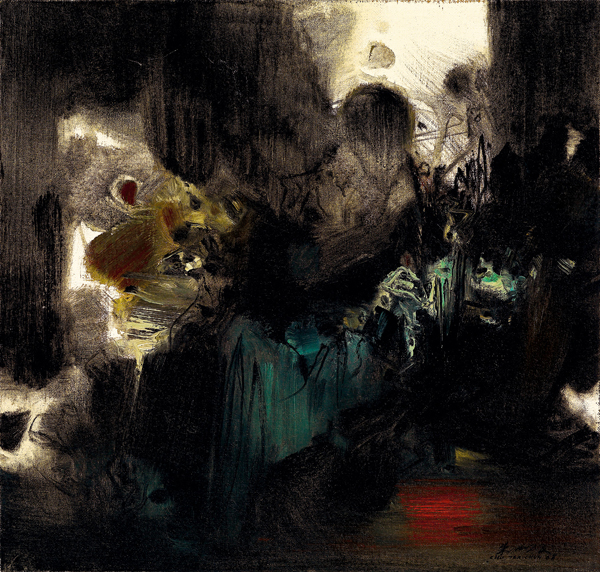In 1960, Chu Teh-chun officially became a member of the École de Paris. At that time, his style was maturing rapidly, and he developed a predilection for largely monochromatic compositions. Chu realized that ink-and-wash techniques with their fluid effusion of colour were eminently suited for the creation of enchanting rhythms and gentle harmonies, and the application of this discovery further enriched his oil paintings. One critic, Li Jiming, has dubbed the years from 1963-1972 Chu's "condensed colour period" writing about the paintings from those years: 'In what I call the condensed colour period, Chu Teh-chun's work breathes the spirit of China's traditional philosophy of yinyang and the five elements ("yinyang wuxing" that stresses the close interaction between humanity and the forces of nature. Where the ground colour is black, covering almost the entire canvas, Chu will yet find some small space to apply exceedingly bright pastel tones. These brighter hues have an incredible density, as if illumined by a powerful light source and piercing directly through multiple layers of mist and vapour. While the main motif may be expressed in subdued and muddy shades, this is compensated for with dazzling, saturated hues that are applied here and there in small swabs to enhance our understanding of the image conveyed. Chu's outstanding skill in the use of colour is generally acknowledged. Even the brightest red, the deepest sapphire or the freshest green are never allowed to dominate the entire composition, but are skillfully placed in a larger context. Even strongly contrasting or discordant hues will magically appear united in harmony under Chu's delicate brushstrokes. Chu heaps layer upon layer of colour, as if filling up an ocean of possibilities with concrete shapes and motifs, rising like a hill in the painting's centre of gravity, and sending out rays of fluid rhythm in all directions, effervescent and natural for all their elaborate sophistication.' (cf. Li Jiming, 'Chu Teh-chun's Road as a Painter' in Fine Art Studies 15: The China-Paris Connection. Studies on the First Generation of Chinese Painters in France, Taipei: Taipei Fine Arts Museum, 1989, p. 121)
The painting "Composition No. 288" has the feature and style of Chinese mountain-water paintings. The sweep of the brush horizontally separates the canvas into upper and lower spaces. The overlapped colors form endless mountains; the thin lines constitute rhythms as if a gentle breeze. The painting shows a fascinating landscape where color patches of red, blue and green add charm to the single dominant color, enriching the hierarchies of the structure of the picture. A change in style of the gallery agency in 1962 brought about a low point for Chu Teh-chun for some years. This is a forgettable period for Chu in Paris. A difficult life and low income, however, never influenced his work as a pure-hearted and clear-minded painter. His paintings in the 1960s were less in quantity, but greatly superior in quality.
